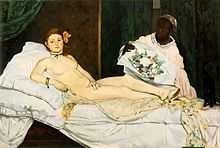In the Conservatory
 | |
| Artist | Édouard Manet |
|---|---|
| Year | 1878–9 |
| Type | Oil on canvas |
| Dimensions | 115 cm × 150 cm (45.3 in × 59.1 in) |
| Location | Alte Nationalgalerie, Berlin |
In the Conservatory (French: Dans la serre) is an 1879 oil painting by Édouard Manet in the Alte Nationalgalerie, Berlin. The setting is a conservatory at 70 Rue d'Amsterdam in Paris, then owned by painter Otto Rosen and which Manet used as a studio for nine months in 1878 and 1879.[1] At first glance, we see a double portrait of a fashionable and attractive couple of some social rank. They are Manet's friends, the Guillemets, who owned a clothing shop. Their married status is conveyed by their rings, and the proximity of their hands is the nearest hint of intimacy. The woman becomes the focus of the portrait, however, being more prominently placed and colourfully dressed. Their physical separation—with the husband Jules slouching in dark clothing behind the bench—and their lack of engagement with the viewer create a sense of detachment, which has been the primary theme in modern criticism of the work.[2]
The painting was exhibited in the 1879 Paris Salon and was regarded as surprisingly conservative for Manet. Jules-Antoine Castagnary wrote, with tongue in cheek, "But what is this? Face and hands more carefully drawn than usual: is Manet making concessions to the public?"[3]—and said it portrayed "the elegance of fashionable life".[1] Yet the portrait is not entirely conventional—the sense of dislocation carries to the background. Joris-Karl Huysmans called the subjects "marvelously detached from the envelope of green surrounding them".[4] The interplay of lines formally defines the work. The woman has an erect posture echoed by the vertical slats of the bench, and the man, though leaning forward, does not break that vertical. The bench continues off the right side, reinforcing the horizontal and the separation of foreground and background. The diagonal pleats on the woman's dress provide some relief from the linearity of the composition.
Jean-Baptiste Faure bought In the Conservatory from Manet, along with three other paintings, for the "paltry sum" of 11,000 francs.[5] It was taken from the Gemäldegalerie in Berlin during the Nazi plunder[6] but recovered in 1945 in a German salt mine stashed with a vast amount of art and other valuables. A photograph (below) in the U.S. National Archives and Records Administration shows soldiers in the mine posing with this particular work.
Gallery
-
A portrait of Manet's wife, Suzanne, in a similar setting and also from 1879
-

The caricaturist Morel-Retz (pseudonym "Stop") published this caricature of In the Conservatory in 1879.
-

The painting was looted under Nazi Germany. This 1945 photograph shows US soldiers with the painting in the Merkers salt mine.
Notes
- ↑ 1.0 1.1 Herbert, R. L. (1991). Impressionism: Art, Leisure, and Parisian Society. New Haven, Conn: Yale University Pres; p. 182. ISBN 0300050836
- ↑ Lehmbeck, 107–109; at length in Crary
- ↑ Quoted in Crary, 90
- ↑ Quoted in Lehmbeck, 109, fn 85
- ↑ Brombert, 450
- ↑ "Art". New York Magazine: 60. September 19, 1983. ISSN 0028-7369.
References
- Brombert, Beth Archer (1997). Edouard Manet: Rebel in a Frock Coat. University of Chicago Press. ISBN 0226075443.
- Crary, Jonathan (2001). Suspensions of Perception: Attention, Spectacle, and Modern Culture. MIT Press. ISBN 0262531992.
- Lehmbeck, Leah Rosenblatt (2007). Edouard Manet's Portraits of Women. New York University/ProQuest. ISBN 0549099662.
External links
- In the Conservatory gigapixel image at the Google Art Project
- smARThistory: Manet's In the Conservatory
- ArtSleuth : Manet's In the Conservatory video analysis
| ||||||||||||

